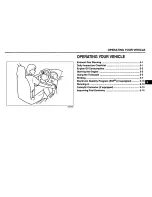
Useful information
These Operating Instructions describe all mod-
els as well as standard and optional equipment
of your vehicle that were available at the time of
going to print. Country-specific variations are
possible. Note that your vehicle may not be fit-
ted with all of the described functions. This also
applies to safety-relevant systems and func-
tions.
Read the information on qualified specialist
workshops: (
Y
page 32).
Engine compartment
Bonnet
Important safety notes
G
WARNING
An unlocked bonnet may open up when the
vehicle is in motion and block your view. There
is a risk of an accident.
Never unlock the bonnet when driving. Before
every trip, ensure that the bonnet is locked.
G
WARNING
If you open the bonnet while the engine is
overheating or while there is a fire in the
engine compartment, you could come into
contact with hot gases or other leaking ser-
vice products. There is a danger of injury.
Allow an overheating engine to cool down
before opening the bonnet. If there is a fire in
the engine compartment, leave the bonnet
closed and notify the fire brigade.
G
WARNING
There are moving components in the engine
compartment. Certain components may con-
tinue to move or suddenly move again even
after the ignition has been switched off, e.g.
the radiator fan. There is a risk of injury.
If you have to carry out work in the engine
compartment:
R
switch off the ignition
R
never touch the dangerous areas surround-
ing moving components, e.g. the rotation
area of the fan
R
remove jewellery and watches
R
keep items of clothing and hair, for exam-
ple, away from moving parts.
G
WARNING
The fuel injection system operates with a high
voltage. If you touch the live components, you
could receive an electric shock. There is a
danger of injury.
Never touch components of the fuel injection
system when the ignition is switched on.
The live components of the fuel injection system
are, for example, the injectors.
G
WARNING
Certain components in the engine compart-
ment could be very hot, e.g. the engine, the
radiator and parts of the exhaust system.
There is a risk of injury when accessing the
engine compartment.
As far as possible, allow the engine to cool
down and only touch the components descri-
bed in the following.
If you have to carry out work in the engine com-
partment, only touch the components described
in the following:
R
bonnet
R
oil dipstick
R
engine oil filler neck cap
R
washer fluid reservoir cap
R
coolant expansion tank cap
Opening the bonnet
G
WARNING
If you open the bonnet while the engine is
overheating or while there is a fire in the
engine compartment, you could come into
Engine compartment
323
Maintenance and care
Z
















































